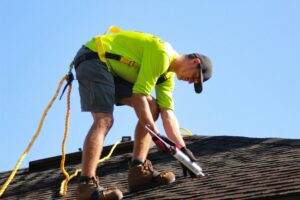When it comes to home health, most attention is directed inward—air purifiers, safe cleaning products, filtered water. But many of the threats to your indoor air quality and family’s well-being actually originate just outside your walls.
From moisture and pests to poor drainage and structural wear, what’s happening on the outside of your house plays a much bigger role than most homeowners realize. Ignoring these exterior details can quietly compromise the health, comfort, and safety of everyone inside.
How Outdoor Issues Become Indoor Problems
Your home’s exterior acts as a protective barrier. When that barrier weakens or breaks down, it allows outside elements to disrupt your indoor environment. Consider the domino effect of these common issues:
- Roof or siding leaks create hidden moisture pockets—prime territory for mold and mildew to spread.
- Blocked gutters lead to standing water, which attracts insects and breeds bacteria.
- Gaps or cracks in foundations and siding invite in rodents and bugs that carry allergens and disease.
- Worn-out insulation or poor ventilation lets dust, pollen, and polluted air seep in, making breathing more difficult.
What starts as minor exterior wear can escalate into costly damage and chronic respiratory discomfort—especially for children or those with allergies.
Warning Signs You Shouldn’t Ignore
It doesn’t take a trained inspector to spot the early signals of trouble. Be on the lookout for:
- Musty smells that linger indoors
- Blistering paint or soft, warped siding
- Dripping sounds or visible staining on ceilings
- Pest droppings, scratching noises, or nesting debris
- Pools of water forming near the foundation after storms
These symptoms often mean the exterior of your home needs immediate attention.
Maintenance That Makes a Difference: Seasonal Priorities
A little prevention can go a long way. Following a seasonal home exterior checklist helps you stay ahead of damage and preserve indoor comfort year-round.
Spring
- Assess the roof, gutters, and flashing for storm damage
- Test for cracks or seepage in basement and foundation areas
- Rinse debris from downspouts to ensure clear drainage
Summer
- Wash siding and outdoor surfaces to remove dirt and mildew
- Trim vegetation to prevent pests and reduce moisture buildup
- Monitor gutters after heavy rains to ensure proper flow
Fall
- Clear fallen leaves from roof valleys and gutter systems
- Inspect and reseal window and door gaps
- Winterize vulnerable pipes and entry points
Winter
- Check attic ventilation and insulation levels
- Watch for ice dams forming at the roofline
- Run dehumidifiers in crawl spaces to minimize indoor moisture
Each of these steps supports a healthier, more resilient home environment.
Why Exterior Care Is a Smart Investment
The cost of skipping seasonal maintenance can be steep. A missed roof leak may lead to expensive mold remediation. Improper grading around the foundation can invite basement flooding or cracking.
Routine inspections and minor upkeep are far more affordable than sudden emergency repairs—and they help preserve not only your property value but your peace of mind.
Take Care of What’s Outside to Protect What’s Inside
Your house’s exterior isn’t just for looks—it’s a vital system that supports indoor air quality, structural soundness, and everyday well-being. Giving it the attention it deserves helps safeguard your family’s health from the ground up.
A well-maintained exterior is more than a good habit—it’s a proactive step toward a safer, cleaner home.
For more on this, check out the accompanying resource from Lane’s Contracting, specialists in window replacements in the greater triangle area.



